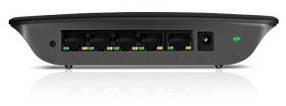Should I use a managed switch or an unmanaged switch with PROFINET? Yes. Yes, you should use either a managed or an unmanaged Ethernet switch with PROFINET.
An unmanaged switch has no built-in intelligence except to send incoming Ethernet frames out the right port – the port that the destination device is connected to. And only that port. For diagnostics it has LEDs. Each port has an LED indicating that there is Ethernet traffic. There is no way to tell how much bandwidth is being consumed. There is no way to tell if there are lots of retries. You can buy such a switch at Best Buy. I just found a 5-port Linksys  switch on bestbuy.com for $33.99. It meets the minimum requirements for PROFINET; that is, it’s a 100Mbps Ethernet switch. It also includes the QoS (Quality of Service) feature that is recommended for PROFINET. Since PROFINET frames are automatically marked with a priority higher than TCP/IP frames, a PROFINET frame gets a head start if a TCP/IP frame and PROFINET frame arrive at the same time. The PROFINET frame gets sent out first.
switch on bestbuy.com for $33.99. It meets the minimum requirements for PROFINET; that is, it’s a 100Mbps Ethernet switch. It also includes the QoS (Quality of Service) feature that is recommended for PROFINET. Since PROFINET frames are automatically marked with a priority higher than TCP/IP frames, a PROFINET frame gets a head start if a TCP/IP frame and PROFINET frame arrive at the same time. The PROFINET frame gets sent out first.
A managed switch adds intelligence that an unmanaged switch does not have. A number of IT protocols are useful with managed switches including SNMP (Simple Network Management Protocol), LLDP (Link Layer Discovery Protocol), and IGMP (Internet Group Management Protocol. Let’s dispense with IGMP right off the bat – PROFINET does not need it. Protocols that multicast their IO data do need it. PROFINET unicasts. SNMP and LLDP are specialized protocols for retrieving data that switches save. For example, if you think it is important to be alerted if there are an excessive number of retries, SNMP can help. If you want to see what bandwidth utilization is in real-time, SNMP can help. LLDP allows software to extract the network topology. LLDP also enables one of the wow-factors of PROFINET: replacing a device with no software tools needed and no switches to set. You can see how that is done in this MinutePROFINET video and watch it being done in this video from our PROFINET one-day training classes.
I often say “You will either use a managed switch… or wish you had.” A managed switch provides information that can help prevent downtime and speed troubleshooting when the line does go down. The more expensive downtime is in your facility, the more important it is to invest in a managed switch. It is an investment. Managed switches cost more. But the incremental cost is trivial compared to the cost of downtime. Up to now, you probably think I’m talking about standalone Ethernet switches. Ok, I have been. But managed switches are also contained within PROFINET devices. So the same kind of diagnostic information you can extract from a standalone switch can be extracted from a switch in a PROFINET device.
So, even though you can, don’t use an unmanaged switch unless you can afford… the downtime.
–Carl Henning
Download the Ethernet switches white paper:
